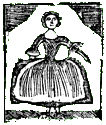Tracing Sarah Church and Her Children
 By July 1777, Sarah Church, wife of accused traitor Dr. Benjamin Church, realized that she was no longer welcome in America. A mob carrying off your possessions tends to have that effect. Sarah gathered the silver plate that remained and bought passage for herself and her children to France, and from there to Britain.
By July 1777, Sarah Church, wife of accused traitor Dr. Benjamin Church, realized that she was no longer welcome in America. A mob carrying off your possessions tends to have that effect. Sarah gathered the silver plate that remained and bought passage for herself and her children to France, and from there to Britain.
The dates of their voyages aren’t clear. Back in Massachusetts, the state included Church’s name on its list of people banished for disloyalty in October 1778, and confiscated his Boston house for sale to support the war effort.
In England, Sarah Church petitioned the Crown for support. She referred to “certain services” that her husband had done for the Crown, and said Gen. Thomas Gage could provide more details. A Mr. Sparhawk testified on her behalf, saying that Dr. Church had been a British spy. In addition, a Loyalist named William Warden stated in his own petition for support that “he was sent by General Gage to Salem and Marblehead to receive intelligence from Dr. Benjamin Church, but failed to execute his business.”
These documents seem to confirm what the American authorities of that time were never quite able to prove: that Dr. Church had been a paid spy for the Crown.
The royal government granted Sarah Church an annual pension of £150, which she collected until her death in August 1788.
The couple’s two sons, Benjamin (born 1758) and James Miller (born 1759), had apparently both started to train as doctors under their father when he was arrested.
According to Boston author James Spear Loring, who said he got information from Church descendants, Benjamin “married a lady of London, and became a surgeon in the British army.” Some books don’t mention Benjamin, apparently because there’s no record of his baptism in Boston (the family may not have moved from Rhode Island yet), and he wasn’t mentioned in his grandmother’s 1794 will (so perhaps he died before that year).
James Miller “was granted an appointment as surgeon’s mate and ensign to the West Middlesex Militia in England”; he retired as that militia’s surgeon in 1817 and died fourteen years later, receiving a small pension as a Loyalist of £12.10s. per year.
The family also included two girls, Sarah (born 1761) and Hannah (born 1764). I find it notable that there’s no sign the Churches had any children after that—four is a small number for an eighteenth-century couple who could have children at all. Benjamin and Sarah Church might therefore have been estranged for a decade before the Revolution.
The younger Sarah Church married a Loyalist refugee named Benjamin Weld. Some sources say he was also her cousin, and she indeed had a cousin of that name. But it’s more than possible that there were multiple Benjamin Welds.
Hannah married a London merchant named William Kirkly and had sixteen children, said Loring in the 1852 edition of his Hundred Boston Orators. However, in the next edition of that book, published two years later, Loring said her husband was named Kirkby. (Other sources use the spellings Kilby and Kirby, just to confuse matters further.) Loring said “a descendant of this branch” was his source on the Church family, meaning they kept up some sort of connection with people in Massachusetts.
In fact, a “Mrs. Hannah Kirkby” married William Longhurst in Boston in 1807. That year’s town directory listed Longhurst as a shopkeeper on Newbury Street. I’ve seen a report that government records from the War of 1812 list William and Hannah Longhurst as British subjects living in Boston; Hannah was said to be forty-five years old, meaning she was born in 1767. John Haven Dexter’s genealogical notes in an earlier town directory (part of the collection of the New England Historic Genealogical Society) state that Mrs. Hannah Longhurst died on 7 Apr 1836 at age 68—giving a birth year of about 1768.
So was Hannah Kirkby Longhurst the younger daughter of Dr. Benjamin Church, discreetly returning to the town of her birth? Or is this simply coincidence?

No comments:
Post a Comment